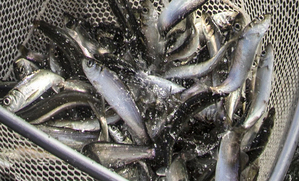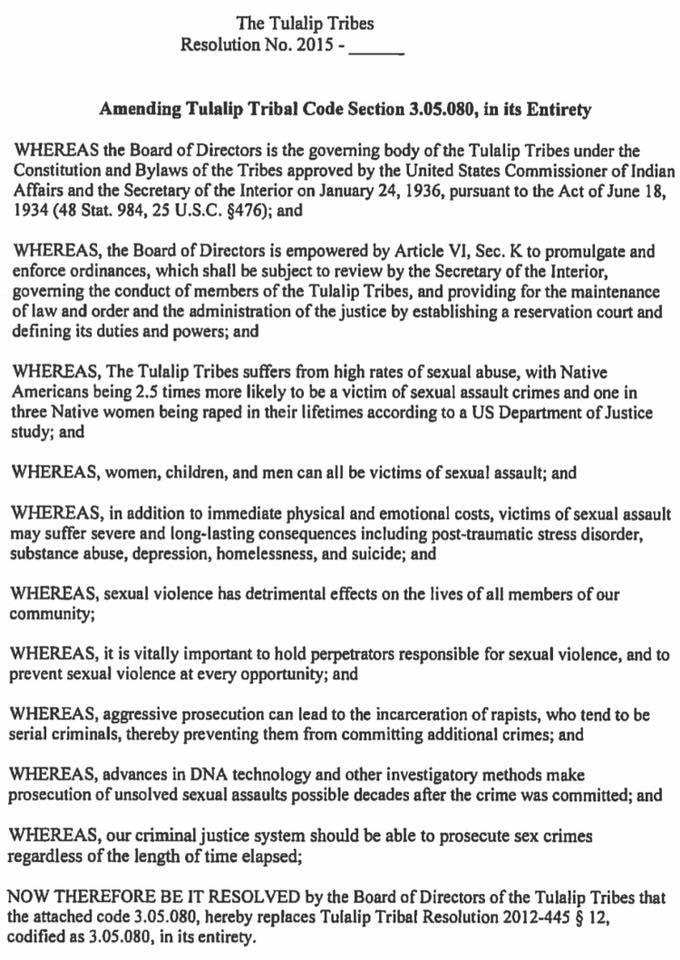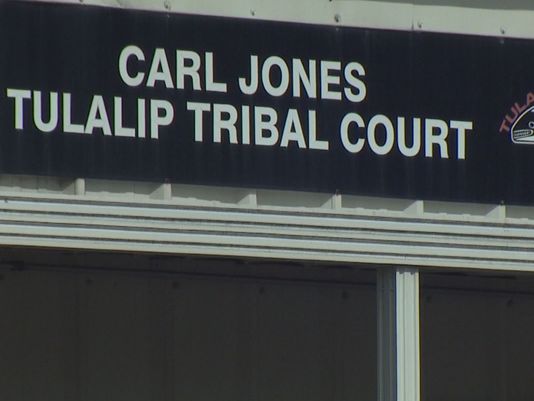Category: News
Judge allows Swinomish lawsuit over oil trains to proceed
By Shannen Kuest, Skagit Valley Herald, goskagit.com
A federal judge ruled Friday that a lawsuit filed by the Swinomish Indian Tribal Community against BNSF Railway over oil train shipments may continue in federal court.
U.S. District Judge Robert Lasnik denied a motion by BNSF to refer key questions to the Surface Transportation Board, a three-member board in Washington, D.C., that oversees railroad operations, according to a news release.
The Swinomish tribe sued BNSF in April for violating the terms of an easement agreement allowing trains to cross its reservation in Skagit County.
The lawsuit concerns train tracks laid along the northern edge of the reservation in the 1800s without consent from the tribe or federal government. The tracks serve two Anacortes oil refineries, and in 1976 the tribe filed a lawsuit for nearly a century of trespass.
In 1991, the tribe and BNSF signed an agreement settling that lawsuit and granting BNSF an easement with several conditions: BNSF would regularly update the tribe on the type of cargo, and only one train of no more than 25 railcars would cross the reservation in each direction daily. In exchange, the tribe agreed not to “arbitrarily withhold permission” from future BNSF requests to increase the number of trains or cars.
The tribe learned from media reports in late 2012 that “unit trains” of 100 railcars or more were beginning to cross the reservation. Today, BNSF is reportedly running six 100-car unit trains per week across the reservation, more than four times as many railcars daily as permitted by the easement, according to the release.
Each of these trains carry between 2.8 million and 3.4 million gallons of Bakken crude, a particularly explosive cargo that has drawn the attention of lawmakers and federal regulators.
The tribe never granted permission to increase the number of railcars and repeatedly demanded that BNSF stop violating the easement. So far, BNSF has refused.
BNSF argued it has a responsibility to provide service, even for hazardous commodities, and that the easement doesn’t give the tribe power to “dictate the commodities that BNSF can handle over the line,” according to the release.
Tribal attorneys argued that the tribe does not want to regulate BNSF operations, but wants BNSF to live up to its contractual obligations.
Lasnik agreed, writing in a six-page ruling that, “In the context of this case, referral to the (transportation board) is neither efficient nor necessary.”
The lawsuit seeks a permanent injunction prohibiting BNSF from running more than one train of 25 cars in each direction and shipping crude oil from the Bakken region across the reservation. The tribe also seeks judgments against BNSF for trespass and breach of contract.
Bringing life back to the Qwuloolt Estuary
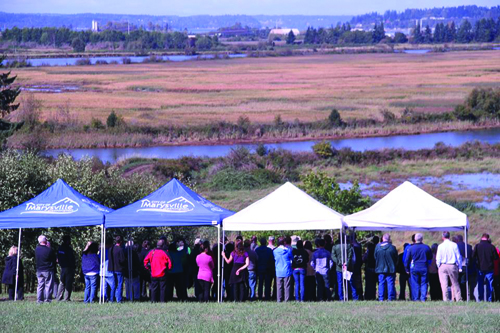
By Micheal Rios, Tulalip News
The Qwuloolt Estuary Restoration Project took 20 years to complete. The finish line was crossed on Friday, August 28, when massive excavators and bulldozers breached a levee and reopened 354-acres of historic wetlands to threatened Puget Sound chinook salmon. The levee breach culminated what has been recognized as the state’s second-largest ever estuary restoration project.
“This is a great, great day. It’s been a long time coming,” says Kurt Nelson, Tulalip Tribes’ Environmental Department Manager, at the September 2 levee breach celebration. “I’ve been on this project for 11 years and there have been many challenges and hurdles, but we’ve gotten through them all. What we have now is a 354-acre estuary wetland complex that saw its first tidal flows in 100 years last Friday [August 28].
“If you watch the live-stream webcam in fast motion, you’ll notice it’s almost like this site is breathing. The estuary is flooding and draining, flooding and draining with tidal waters, like a lung does with oxygen. It’s a nice comparison to bringing some life back to an isolated floodplain that hadn’t seen that kind of life in a longtime.”
The Qwuloolt Estuary Restoration Project (QERR) is a partnership of tribal, city, state and federal agencies aimed at restoring a critical tidal wetland in the Snohomish River estuary. The Qwuloolt Estuary is located within the Snohomish River floodplain approximately three miles upstream from its outlet to Puget Sound and within the Marysville City limits. The name, Qwuloolt, is a Lushootseed word meaning “salt marsh”.
Historically, the area was a tidal marsh and forest scrub-shrub habitat, interlaced by tidal channels, mudflats and streams. However, because of its rich delta soil, early settlers diked, drained and began using the land for cattle and dairy farming. The levees they established along Ebey Slough, as well as the drainage channels and tide gates, effectively killed the estuary by preventing the salt water from Puget Sound from mixing with the fresh water from Jones and Allen Creeks.
For the past 100 years the estuary was cut off from its connection with the tidal waters and denied the ability to act as a restorative habitat for wild-run chinook salmon and other native fish, such as coho and bull trout. Through the cooperation of its many partners, this project has returned the historic and natural influences of the rivers and tides to the Qwuloolt.
The purpose of the project is to restore the Qwuloolt Estuary to historic natural conditions, while also mitigating some of the damage caused by the now defunct Tulalip Landfill on Ebey Island’s northwest edge. The former 145-acre landfill was operated on Tulalip Reservation land by Seattle Disposal Co. from 1964 to 1979 and become a Superfund site (polluted locations requiring a long-term response to clean up hazardous material contaminations) in 1995, before being cleaned up and capped in 2000.
Qwuloolt will provide critical habitat for threatened Puget Sound chinook and other salmon, as well as for waterfowl and migratory birds. Native habitat and functioning tidal marsh ecosystem were lost when the estuary was diked and cut off from tidal influence. This project will restore tidal flows to the historic estuary and promote: Chinook, bull trout, steelhead, coho and cutthroat rearing habitat, salmon access to greater Allen Creek, migratory and resident bird habitat, water quality improvements, Native vegetation growth and restoration, and natural channel formation.
Trying to recover these critical estuary habits are crucial to migrating juvenile salmon for the salmon recovery effort in the Snohomish region. The Qwuloolt Estuary can now, once again, provide food and refuge for those fish. The intent of the project is to increase the production and quantity of those salmon that are extremely important to the Tribe and our cultural-economic purposes, as well as to the public and State of Washington.
“[Qwuloolt] is not only a nursery area for hundreds of thousands of juvenile salmon that migrate from the upper basins of the Snohomish that will come through this estuary and feed on various prey species and grow very rapidly, but also contributes to the survival of fish all over the Snohomish basin,” explains Nelson. “It will improve the water quality of Jones and Allen Creek, while being an extremely important bird habitat for migratory waterfowl, as well as restoring native wetland vegetation.”
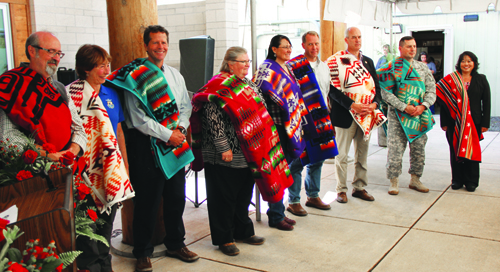
The US Army Corps of Engineers were responsible for the levee construction and the levee breach, while the Tribes were responsible for the channels, the berms, the planting, and some of the utility work that needed to be done. From beginning to end QERR was all about partnership and working together in getting this project done. The US Army Corps of Engineers, the Tulalip Tribes, the city of Marysville, Department of Ecology, National Oceanic and Atmospheric Administration, along with the Puget Sound Partnership and Fish and Wildlife services, all played instrumental roles in completing this project and it could not have been done without the collaboration each and every partner.
“As evidenced here today, it really has been a tremendous collaboration between the tribes and federal, state and local governments to bring this project through and really make a significant change for our environment,” says Col. John Buck of the U.S. Army Corps of Engineers. “Over the past century we’ve seen this continuing degradation of our environment in the northwest and it’s through collaboration and partnership we can really affect change.”
*The Qwuloolt Estuary project cost $20 million. That money was obtained over a 17 year period that involved federal, state and tribal money. It also includes settlement and foundation money. Property purchase was $6 million, $2 million in planning, design, permitting and studies, $10 million on the levee, and another $2 million on constructing channels, berms and all the interior work.
Qwuloolt is:
- Physical stream restoration is a complex part of the project, which actually reroutes 1.5 miles of Jones and Allen creek channels. Scientists used historical and field analyses and aerial photographs to move the creek beds near their historic locations.
- Native plants and vegetation that once inhabited the area such as; various grasses, sedges, bulrush, cattails, willow, rose, Sitka spruce, pine, fir, crab apple and alder are replacing non-native invasive species.
- Building in stormwater protection consists of creating a 6 ½ acre water runoff storage basin that will be used to manage stormwater runoff from the nearby suburban developments to prevent erosion and filter out pollutants so they don’t flow out of the estuary.
- Construction of a setback levee has nearly finished and spans 4,000 feet on the western edge on Qwuloolt. The levee was constructed to protect the adjacent private and commercial property from water overflow once the levee is breached.
- Breaching of the existing levee that is located in the south edge of the estuary will begin after the setback reaches construction. The breaching of the levee will allow the saline and fresh water to mix within the 400-acre marsh.
Other estuary restoration projects within the Snohomish River Watershed include; Ebey Slough at 14 acres, 400 acres of Union Slough/Smith Island and 60 acres of Spencer Island. The Qwuloolt Estuary Restoration Project has been a large collaboration between The Tulalip Tribes, local, county, state and federal agencies, private individuals and organizations.
Contact Micheal Rios at mrios@tulaliptribes-nsn.gov
Low levels of oil pollution harm herring, salmon, study finds
Researchers find oil can harm herring and salmon at much lower levels than once thought. The work raises questions about Puget Sound pollution.
Federal scientists based in Seattle and Alaska have found that oil — by impairing heart functions — can cause serious harm to herring and pink salmon at far lower concentrations than previously documented.
The research, published Tuesday online in Nature’s Scientific Reports, could help unravel the mystery of why herring stocks in Prince William Sound collapsed after the 1989 Exxon Valdez oil spill. Their work also has implications about the effects of low levels of chronic oil pollution in Puget Sound and elsewhere in the world.
“What this study shows is that in very, very low concentration of oil, embryonic fish … get born with a mild heart defect,” said John Incardona, a National Oceanic and Atmospheric Administration toxicologist at a Seattle fisheries science center. He is one of 10 co-authors of the study.
Those fish may look OK on the outside, but the heart defect makes them less fit, so they can’t swim as fast. They may succumb to predators at higher rates than other fish and may be more vulnerable to infections, according to Incardona.
The findings reflect years of studies that explored the effects of polycyclic aromatic hydrocarbons, compounds released by crude oil spills, but also contained in many other forms of fossil-fuel pollution such as tailpipe emissions from Puget Sound motorists that condense and are carried into the water by runoff.
The research examined the effects on fast-growing zebrafish, and then replicated the heart damage in more complex experiments that exposed embryonic herring and pink salmon to oil.
The researchers found that oil’s effects are greatest in cold-water environments, where fish embryos are less able to metabolize the pollutants. And herring, with much smaller eggs than the pink salmon, suffered the most severe effects from the polycyclic aromatics.
In the aftermath of the 1989 Exxon Valdez spill that dumped nearly 11 million gallons of crude in Prince William Sound, Alaska became the first — and so far only state — to create a water-pollution limit for the polycyclic aromatics, according to Incardona.
That Alaska state limit is 10 parts per billion, but the researchers found herring embryos could be affected at levels 10 to 50 times lower than that. At those levels, herring that returned to spawn in Prince William Sound in 1989 as well as subsequent years could have produced offsprings with damaged hearts.
Those offspring would have hatched, but few may have survived long enough to reach spawning age. That could be a big reason spawning stocks of Prince William Sound herring crashed four years after the 1989 spill.
“The thresholds for developmental cardiotoxicity were remarkably low, suggesting that the scale of the Exxon Valdez impact in shoreline spawning habitats was much greater than previously appreciated,” the researchers wrote.
In the more than quarter century since the Exxon Valdez spill, Prince William Sound herring stocks have failed to recover even as oil pollution has declined to levels unlikely to affect them.
The study published Tuesday does not try to explain the herrings’ current problems, although Incardona says once fish stocks get knocked to a very low level, recovery can be very difficult.
The situation is very different in Puget Sound, which has the highest levels of polycyclic aromatics of any estuary due to ongoing chronic pollution, according to Incardona. The Puget Sound levels are not that far below those found to have effects in the aftermath of the Exxon Valdez, and raise questions about whether this pollution is harming Puget Sound’s struggling herring stocks.
Incardona, who said that federal researchers hope to work with Washington state biologists to try to answer that question.
Tulalip Tribes Removes Statute of Limitations on Sex Crimes
On September 3rd, the Tulalip Tribes Board of Directors passed a resolution to remove statute of limitations on sex crimes.
According to Theresa Sheldon, Tulalip Tribes Board of Directors, “Removing the statute of limitations will give the power back to those who have suffered crimes against their spirit and bodies. Prior to this resolution, you only had three years to report a sexual violence crime to authorities. Now those years are no longer valid from this day forward.”
Feds give tribes access to crime database
Source: Chris Ingalls, KING 5
The Tulalip Tribal Courts started a new procedure this week. It’s hoped that it will help reduce crime, like the Marysville Pilchuck High School shootings.
Tulalip – and all tribal courts of law across the country – now have access to the federal crime database called the National Crime Information Center (NCIC).
Before the Marysville shootings on Oct. 24, the U.S. Department of Justice did not allow tribal courts like the Tulalips to access the NCIC. Non-tribal police and courts use the database to check on the criminal histories and court orders of suspects.
A problem came to light when investigators determined that Jaylen Fryberg used his father’s handgun to murder four classmates in Marysville.
A Tulalip Tribal Court protection order barred Raymond Fryberg from owning firearms. But he was able to purchase a handgun from a licensed firearms dealer in 2003 because the court order was not entered in NCIC. The dealer sold Fryberg the gun because the federal background check came up clean.
“If the Tulalip Tribe had the ability to put that information into the system, it would have had the potential to eliminate the father from being able to purchase the weapon,” said Judge Richard Black.
Judge Blake is president of the National American Indian Court Judges Association.
Last month, tribal court organizations convinced the U.S. Department of Justice to allow tribal police and courts to have full access to NCIC so its officers and judges can review criminal histories and enter court judgments into the database.
While Tulalip leaders would not speak on camera citing the sensitivity of the Fryberg case, they confirm that this week tribal police and court officers completed training and they are accessing NCIC directly for the first time.
Judge Blake, who sits on a tribal bench in California, says the new rules mean better community safety both on and off tribal land.
“Without the ability for the tribes to input directly, it delays justice for the victims,” said Judge Blake.
Hard Work Leads To Recovery of Summer Chum
By Lorraine Loomis, Chair, Northwest Indian Fisheries Commission
Hood Canal/Eastern Strait of Juan de Fuca summer chum is the only threatened salmon population in western Washington showing clear signs of recovery.
It’s thanks to a 20-year cooperative effort by state and tribal salmon co-managers, conservation groups, local governments and federal agencies that is balancing the key ingredients needed for recovery: harvest, hatcheries and habitat.
Summer chum were listed as threatened under the Endangered Species Act in 1999 along with Puget Sound chinook and Lake Ozette sockeye. Puget Sound steelhead joined the list in 2007.
The program’s success comes from a core principle that salmon recovery must address all factors affecting natural production. For far too long the federal government’s main response to protect ESA-listed salmon has been to cut harvest. Meanwhile, the primary threat to wild salmon and their recovery – ongoing loss and damage of their habitat – continues to be ignored.
Past overharvest and poor ocean conditions combined with degraded habitat to spark the steep decline of summer chum that began in Hood Canal streams in the late ’70s. By the early 1990s, fewer than a thousand summer chum were returning from a population that once numbered 70,000 or more.
The tribal and state co-managers responded with strong harvest management actions beginning in 1992. Fisheries impacting summer chum were reduced, relocated and delayed to protect the returning fish.
But it didn’t stop there. Working with federal agencies and conservation groups, tribal and state salmon co-managers began hatchery supplementation programs to boost populations of summer chum.
A portion of the wild run returning to the Big Quilcene River was moved to a federal fish hatchery and spawned, with the offspring released to rebuild the remaining run. Four years later, about 10,000 adult summer chum returned to the river.
Since then, additional hatchery supplementation efforts have led to summer chum becoming re-established in most of its historic range. To protect summer chum genetics, supplementation programs were limited to three generations, or 12 years. Some programs met their goals and were ended earlier.
Habitat protection and restoration was the third key to bringing back summer chum. Projects such as dike removals, protecting and restoring instream habitat, planting streamside trees and removing invasive plants have all contributed to the effort’s success. Nearly 700 acres of estuary and an equal amount of upland stream habitat have been improved to support the recovery effort.
More work is planned and ongoing in streams, estuaries, and the nearshore throughout the area
Balancing harvest, hatcheries and habitat is the key to salmon recovery. Equally as important is the need for monitoring and evaluation to apply lessons learned and improve effectiveness.
Cooperation is the third essential ingredient. Only by working together can we hope to meet the challenges of salmon recovery. If we are ever going to recover Puget Sound chinook and steelhead, we will need to use the same approach we are using to save Hood Canal summer chum.
Despite the best efforts of fisheries managers to restore summer chum, they remain vulnerable to climate change and ongoing development. Because they arrive in streams to spawn during the late summer months, they are especially threatened by low flows like those we are seeing during this year’s record-breaking drought, which is far from over.
Ongoing loss of habitat and a number of other factors still must be fully addressed before summer chum can be removed from the ESA list. There’s still a ways to go, but at least we are on the right path.
How will we know when we have recovered summer chum? When they are once again abundant enough to support sustainable harvest. To the tribes, that is the true measure of salmon recovery and the commitment to fulfill the promises of the treaties we signed with the U.S. government.
Detectives Seek Information about Fatal Collision
EVERETT, Wash. – Collision Investigation Unit detectives are looking for information about the fatal collision that occurred last week which killed two men and two juvenile females on the Tulalip Reservation.
Specifically, they are looking for witnesses to the incident or surveillance video of the truck from around 1:30 a.m. on August 18th through the time the accident was reported later that morning (3:30 a.m.).
Detectives are seeking this information to help piece together what may have caused the incident, as well as additional evidence to aid in their investigation.
Anyone with information is asked to call the Sheriff’s Office anonymous tip line at 425-388-3845.
The incident occurred at the 7500 block of Totem Beach Rd. The pickup truck with the four victims went off the roadway, over a concrete embankment, and into a fisheries rearing pond. All four died at the scene.
Seattle School Named After Robert Eagle Staff, Fourth to Have Indigenous Name

The names of Robert Eaglestaff (left) and Billy Frank Jr. were among those being considered for a new middle school proposed on an important Duwamish site in the Licton Springs neighborhood of Seattle. The school will be named for Eaglestaff.
Seattle’s newest middle school will be named for the late Robert Eagle Staff, Lakota, principal of American Indian Heritage High School from 1989-1996.
The Seattle School Board voted June 17 in favor of the naming. “The extensive community engagement naming process has resulted in majority support to honor the accomplishments and legacy of a great educator, Robert Eagle Staff,” said Jon Halfaker, executive director of schools for the Seattle School District’s Northwest region.
“It’s huge” for the Native community, said the late principal’s son, Louis Eaglestaff, who spells his name as one word as his father did. Eaglestaff said the district chose to spell Eagle Staff as two words, out of respect for the wishes of family members in South Dakota who spell it that way.
No matter. “Even though he did so much for students, the school name is validation that [his legacy] is always going to be there,” said Eaglestaff, a kindergarten teacher in nearby Bellevue. “I don’t need validation, because what he did was enough for us. But it’s something to be proud of.”
RELATED: Two Native Leaders’ Names Among Those Being Considered for New Seattle School
Robert Eagle Staff Middle School will be built at the site of the former Wilson-Pacific School, which housed American Indian Heritage School. The new middle school will have room for 850 students, as well as 150 from the American Indian Heritage School program. It is scheduled to be completed in 2017.

The former Wilson-Pacific School site is important to Seattle’s Native community. It is the site of a spring, called Licton (Liq’tid), which is historically and culturally significant to the Duwamish people. American Indian Heritage hosted powwows and cultural programs for young people, and the buildings featured Native-themed murals by artist Andrew Morrison, Apache/Haida. The walls with the murals are being saved and will be incorporated into the new school buildings.
Getting the school named for Eagle Staff was part of a long effort by the Native community—an effort that continues now in trying to rebuild the American Indian Heritage program.
The school board’s vote “is the culmination of a two-year campaign which included active lobbying, a documentary, online petitions, many phone calls, tons of letters written in support, and community meetings,” wrote Sarah Sense-Wilson, Lakota, chairwoman of the Urban Native Education Alliance.
“The next fight is having a Native-focused high school in [Eagle Staff] school.”
During Eagle Staff’s leadership, American Indian Heritage High School had a 100 percent graduation rate with all graduates going on to college. Eagle Staff, a University of North Dakota Hall of Fame basketball player, passed away unexpectedly at age 43, and enrollment in the school he led started to decline amid changes in funding and program support.
The school buildings fell into disrepair as the district diverted funding to other priorities. By 2012, plans were developed to build a new school to accommodate projected enrollment growth and alleviate overcrowding in three other middle schools. In 2013, voters approved a capital levy to fund construction of several new schools and to modernize others. In 2014, the American Indian Heritage School program was merged with a program from another school, also closed for new construction, renamed Licton Springs, and moved temporarily to another site.
“Licton Springs is going to take another 3-5 years of development to reach a level of Native focus we think is authentic,” Sense-Wilson wrote in an email. “Still no Native staff, no language, no cultural programming at Licton. A majority of the kids are non-Native.”
Seattle Public Schools Superintendent Larry Nyland recommended the school board name the school in honor of Eagle Staff based on input at community meetings and comments from 190 members of the public. Supporters at the final community meeting on May 4 included members of Eagle Staff’s family. Only three people at the meeting spoke in favor of naming the school after another nominee, Dr. Caspar Sharples, an early 20th century Seattle physician and co-founder of Children’s Hospital. Other names considered included Billy Frank Jr., Nisqually (1931-2014), treaty rights activist and environmental leader.
A 660-student elementary school will be built adjacent to Robert Eagle Staff Middle School. The school board voted to name it Cascadia, after the geographic bioregion that includes Washington, Oregon and British Columbia. Other names nominated included author-poet-playwright Sherman Alexie, Spokane; author-poet-actor Maya Angelou; Josephine Corliss Preston (1873-1958), the first woman elected to state office in Washington; and Dr. Caspar Sharples.
Several indigenous nations have ties to Seattle, including the Duwamish Tribe, the Muckleshoot Tribe, and the Suquamish Tribe. Of 92 public schools in Seattle, only four have indigenous names: Leschi, the mid-1800s Nisqually leader; Sacajawea, the Lemhi Shoshone interpreter and guide for the Lewis and Clark Expedition; Chief Sealth (an anglicization of Si’ahl), the mid-1800s leader of the Duwamish and Suquamish; and Eagle Staff.
Read more at http://indiancountrytodaymedianetwork.com/2015/07/12/seattle-school-named-after-robert-eagle-staff-fourth-have-indigenous-name-161015
Tribal Casino In Michigan Stops Revenue-Sharing Payments Because Of Online Lottery Launch
The Gun Lake Tribe Says I-Lotto Violates Compact
By Brian Pempus, www.cardplayer.com
A Native American tribe with a casino in Michigan has stopped paying the state its cut because the state elected to offer lottery games on the Internet.
The tribe believes the state violated their revenue-sharing compact by launching online lottery products last summer. The compact was negotiated back in 2007.
The Gun Lake Tribe stopped making payments in June. The Michigan Economic Development Corporation receives roughly $60 million annually from the state’s tribal casinos. The Gun Lake Casino contributes roughly $13.3 million to the state annually.
According to crainsdetroit.com, other tribes may follow suit and stop their respective payments. Michigan has 12 tribes that have gambling facilities.
So far in 2015, online lottery sales have yielded $15.9 million for the state.
Americans spent more than $70 billion on the lottery in 2014, which makes it the most popular form of gambling in the country. More and more states are considering offering games on the Internet, with the most recent being North Carolina, according to a report from the Winston-Salem Journal. Florida is also considering bringing the games to the Internet one day.
State lotteries basically were given permission by the federal government to pursue online lottery services and products when the Department of Justice re-interpreted the Wire Act in December 2011. That move also resulted in three states launching online poker.





